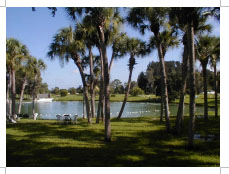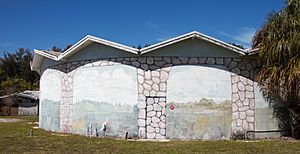Warm Mineral Springs (spring) facts for kids
Quick facts for kids |
|
|
Warm Mineral Springs
|
|

Warm Mineral Springs Park entrance
|
|
| Location | Warm Mineral Springs, Florida |
|---|---|
| NRHP reference No. | 77000408 |
| Added to NRHP | November 28, 1977 |
The Warm Mineral Springs is a special water-filled hole in the ground, called a sinkhole. It is located in North Port, Florida, close to U.S. 41. The main water source is a spring deep below the surface. This is the only warm water mineral spring in the entire State of Florida!
It is a very important geological and archaeological site. This means it tells us a lot about Earth's history and ancient people. Scientists have found signs of Native American life here. Since the 1960s, it has been used as a natural spa, a place where people relax in the water. People come from all over the world to swim in its mineral-rich waters. Some even thought it might be the famous Fountain of Youth that Ponce de Leon searched for! The springs were added to the National Register of Historic Places in the United States on November 28, 1977. After being closed for a while, the springs reopened for swimming in 2014.
Contents
What is Warm Mineral Springs?
Warm Mineral Springs is a large sinkhole. It formed about 30,000 years ago. This happened when the roof of an underground cavern made of carbonate rock collapsed. The land around the sinkhole is flat. It is about 3 meters (10 feet) above sea level.
The opening of the sinkhole at the water's surface is about 72 meters (236 feet) wide. The sinkhole is very deep, about 70 meters (230 feet). It looks a bit like an hourglass shape. It gets narrower below the surface, then widens again. At the very bottom, there's a large pile of rocks and other material. This pile comes from the collapsed roof and sides of the sinkhole.
How the Sinkhole Formed
Florida's environment was very different during the Pleistocene period. This was a long time ago, during the last ice age. Huge amounts of water were frozen in ice sheets. This made the sea level about 100 meters (330 feet) lower than it is today. Florida had twice as much land back then.
The climate was also cooler and much drier. There were not many rivers or springs flowing. The few water sources were rain-fed lakes and deep sinkholes. These sinkholes, like Warm Mineral Springs, were partly filled by underground springs. About 12,000 years ago, the water level in the sinkhole was about 30 meters (100 feet) lower. You can see stalactites and stalagmites on the walls. These formed when the water level was much lower.
The Water in the Springs
Many small freshwater springs flow into the sinkhole. But the main source is a vent 63 meters (207 feet) below the water's surface. This vent releases about 20 million gallons of warm, mineralized water every day! The water is about 30°C (86°F).
This water has a lot of dissolved chloride and hydrogen sulfide. It has almost no oxygen. Scientists are still not sure where all this water comes from. The water flows into the sinkhole through an underground passage. This passage is about 1 meter (3 feet) high and 3 meters (10 feet) wide. It leads to two small caverns. A lot of water overflows from the sinkhole each day.
History of Warm Mineral Springs
In the late 1950s, William Royal and other scuba divers explored Warm Mineral Springs. They found old tools and human bones. These bones belonged to at least seven different people. A piece of wood found with some bones was dated to about 10,000 years ago. If the bones were that old, they would be the oldest proof of humans in Florida at that time.
The bones and tools were likely placed above the water level back then. One skull found deep in the sinkhole still had some organic material inside. Doctors who looked at it thought it might be brain matter. Tests showed it was consistent with brain tissue.
Protecting the Site
The land around the springs was privately owned. It was turned into a spa in the 1960s. At first, people could go in freely. Sadly, some scuba divers took human bones, artifacts, and rock formations as souvenirs. Almost all the important items were removed before scientists could study them properly. In the 1970s, the owners started limiting access. They wanted to stop people from taking things.
Public agencies that own land must protect historical sites. They hire archaeologists to find and care for old artifacts. Private landowners have some freedom, but they cannot disturb unmarked graves. These are protected by law.
Wilburn Cockrell, an archaeologist from Florida State University, began working at the springs in 1972. His work helped convince the private owner to protect the site. This was because of its great archaeological importance. Scientific exploration stopped in 1975 but started again in 1984. During this second phase, they found evidence that early humans made tools there. They found signs of both Paleo-Indian and Archaic cultures.
Ancient Discoveries
Wilburn Cockrell called Warm Mineral Springs a "burial ground." He believed it was used by an ancient community from a nearby site called Little Salt Spring. In 1988, Cockrell said they found the remains of over 20 Paleoindian people. Some of these remains were dated to 12,000 years ago.
Archaeologists also found bones of ancient animals. These included a giant ground sloth, a saber-toothed cat, a horse, and a camelid. Cockrell even found an 11,000-year-old human skeleton. It was placed in a crevice, held in place by broken stalactites. This might be the oldest known intentional burial in North America!
In 1996-1997, a group of divers explored the site underwater. They mapped two warm water vents and two cool water vents. They also filmed the deepest warm water vent. On December 20, 2010, Sarasota County and the city of North Port bought Warm Mineral Springs for $5.5 million.
Buildings at the Springs
The buildings at Warm Mineral Springs were built in the late 1950s. They are believed to have been designed by Jack West, an architect from the Sarasota School of Architecture. The main entry building has a gift shop, locker rooms, showers, and a restaurant.
There is also a separate round building called the "Cyclorama." Inside, it has a huge 360-degree painting. This mural is 226 feet long and 13 feet high. It shows nine scenes of Ponce de Leon arriving in Florida in 1513. It also shows his search for the Fountain of Youth. This is because Warm Mineral Springs was thought to be that famous fountain.
The Cyclorama was created in 1959. It was part of celebrations for the 400th anniversary of Tristan de Luna's settlement in Pensacola. The large mural was painted by a local artist named Don Putman. It used to have a 22-minute story told by Lowell Thomas. The Cyclorama has been closed since the 1970s, and its future is uncertain.





